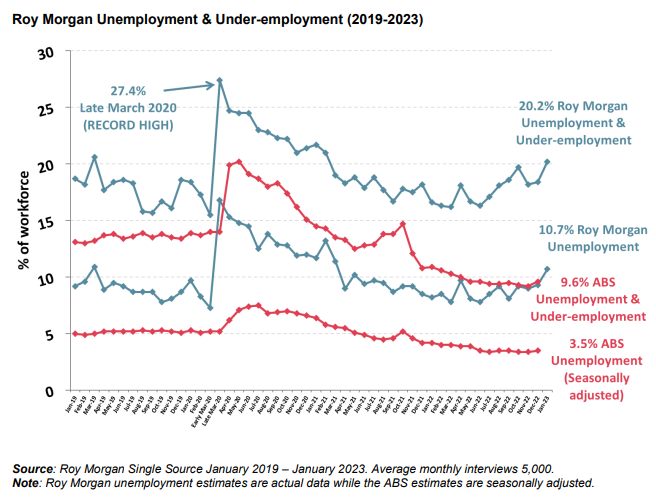Roy Morgan’s unemployment estimate recorded its biggest increase since JobKeeper ended in March 2021.
The unemployment rate rose 1.4% to 10.7%, driven by a fall in part-time employment after Christmas, alongside more people joining the workforce:

Below are the key movements from the release:
Employment dropped in January driven by a decrease in part-time employment:
Australian employment decreased by 150,000 to 13,418,000 in January. The decrease was driven by a drop in part-time employment, down 280,000 to 4,517,000, while full-time employment increased, up by 130,000 to 4,797,000. The movements in both full-time and part-time employment were in line with the normal seasonal trends seen at this time of year following the Christmas retailing season.
Unemployment was up in January with more people looking for both full-time and part-time work:
1,607,000 Australians were unemployed (10.7% of the workforce) in January, an increase of 223,000 from December with more people looking for full-time work, up 49,000 to 644,000 and more people looking for part-time work, up 174,000 to 963,000 – both at their highest since March 2021.
The workforce increased to a record high of over 15 million in January:
The workforce in January was 15,025,000 (up 73,000 from December) – comprised of 13,418,000 employed Australians (down 150,000) and 1,607,000 unemployed Australians looking for work (up 223,000).
Overall unemployment and under-employment above 3 million for first time in two years:
In addition to the unemployed, 1.43 million Australians (9.5% of the workforce, up 0.4% points) were under-employed – working part-time but looking for more work, up 65,000 from December.
In total 3.03 million Australians (20.2% of the workforce) were either unemployed or under-employed in January, up a large 288,000 on December. This is the highest level of combined unemployment and under-employment for two years since February 2021 (3,068,000, 21.0% of the workforce).
Michele Levine, CEO Roy Morgan, noted that “the usual seasonal trends were seen in January as part-time employment dropped after the preChristmas retailing season, down 280,000 to 4,517,000 while full-time employment increased, up 130,000 to 4,797,000. Both of these trends are usually observed during the new year period as parttime retailing jobs dry up and people begin new full-time jobs to start the year”.
Levine also questioned the incessant whining over labour shortages, noting that “despite the complaints from some sectors who can’t find enough people to work in their industries, there continues to be a large pool of millions of Australians who are looking for work or looking for more work”.
With immigration rising fast, labour supply will continue to grow strongly, pushing unemployment higher over 2023.

